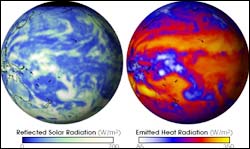Scientists Confirm Earth’s Energy Is Out of Balance

Clouds and the Earth’s Radiant Energy System (CERES) measurements show the reflected solar radiation (left) and emitted heat radiation (right) for January 1, 2002. In both images, the lightest areas represent thick clouds, which both reflect radiation from the Sun and block heat rising from the Earth’s surface. Notice the clouds above the western Pacific Ocean, where there is strong uprising of air, and the relative lack of clouds north and south of the equator. Credit: NASA
Scientists have concluded more energy is being absorbed from the sun than is emitted back to space, throwing the Earth’s energy “out of balance” and warming the globe.
Scientists from NASA, Columbia University, New York, and Lawrence Berkeley National Laboratory, Berkeley, Calif. used satellites, data from buoys and computer models to study the Earth’s oceans. They confirmed the energy imbalance by using precise measurements of increasing ocean heat content over the past 10 years.
The study reveals Earth’s energy imbalance is large by standards of the planet’s history. The imbalance is 0.85 watts per meter squared. That will cause an additional warming of 0.6 degrees Celsius (1 degree Fahrenheit) by the end of this century.
To understand the difference, think of a one-watt light bulb shining over an area of one square meter (10.76 square feet). Although it doesn’t seem like much, adding up the number of feet around the world creates a big effect. To put this number into perspective, an imbalance of one-watt per square meter, maintained for the past 10,000 years is enough to melt ice equivalent to one kilometer (.6 mile) of sea level, if there were that much ice.
“The energy imbalance is an expected consequence of increasing atmospheric pollution, especially carbon dioxide, methane, ozone, and black carbon particles. These pollutants block the Earth’s heat radiation from escaping to space, and they increase absorption of sunlight,” said Jim Hansen of NASA’s Goddard Institute for Space Studies, New York. He is the lead author of the new study, which is in this week’s Science Magazine Science Express.
As the Earth warms it emits more heat. Eventually the Earth will be back in balance, if the greenhouse gas emissions are kept at the same level of today. Scientists know it takes the ocean longer to warm than the land. The lag in the ocean’s response has practical consequences. It means there is an additional global warming of about one degree Fahrenheit that is already in the pipeline. Even if there were no further increase of human-made gases in the air, climate would continue to warm that much over the next century.
Warmer world-wide water temperatures also affect other things. “Warmer waters increase the likelihood of accelerated ice sheet disintegration and sea level rise during this century,” Hansen said. Since 1993, sea levels have been measured by satellite altimeters. Data has shown they have risen by approximately 3.1 centimeters or 1.26 inches per decade.
Although 3.1 centimeters is a small change, the rate of increase is twice as large as in the preceding century. There are positive feedbacks that come into play, as the area of ice melt increases. The researchers agree monitoring ice sheets and sea level is necessary to best ensure the system is in balance.
Media Contact
All latest news from the category: Earth Sciences
Earth Sciences (also referred to as Geosciences), which deals with basic issues surrounding our planet, plays a vital role in the area of energy and raw materials supply.
Earth Sciences comprises subjects such as geology, geography, geological informatics, paleontology, mineralogy, petrography, crystallography, geophysics, geodesy, glaciology, cartography, photogrammetry, meteorology and seismology, early-warning systems, earthquake research and polar research.
Newest articles

Silicon Carbide Innovation Alliance to drive industrial-scale semiconductor work
Known for its ability to withstand extreme environments and high voltages, silicon carbide (SiC) is a semiconducting material made up of silicon and carbon atoms arranged into crystals that is…

New SPECT/CT technique shows impressive biomarker identification
…offers increased access for prostate cancer patients. A novel SPECT/CT acquisition method can accurately detect radiopharmaceutical biodistribution in a convenient manner for prostate cancer patients, opening the door for more…

How 3D printers can give robots a soft touch
Soft skin coverings and touch sensors have emerged as a promising feature for robots that are both safer and more intuitive for human interaction, but they are expensive and difficult…




















